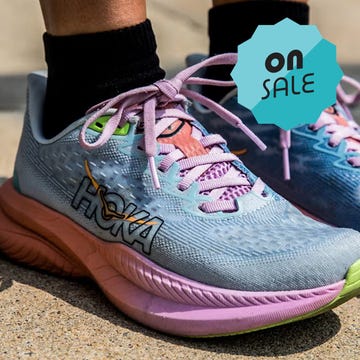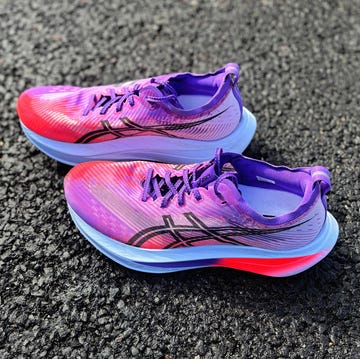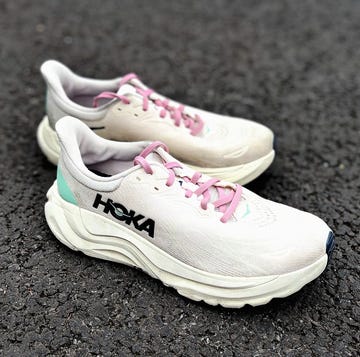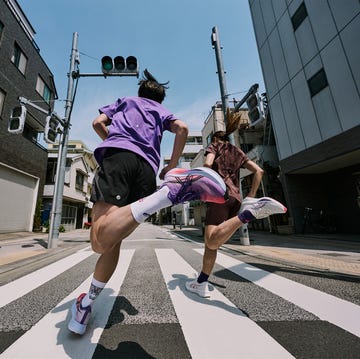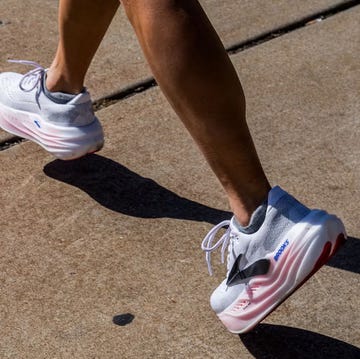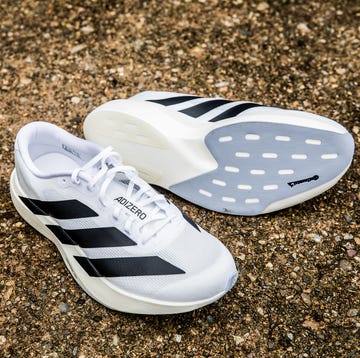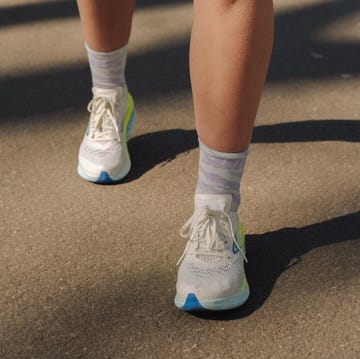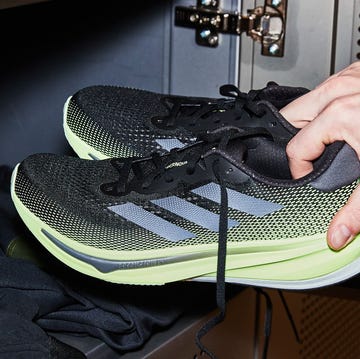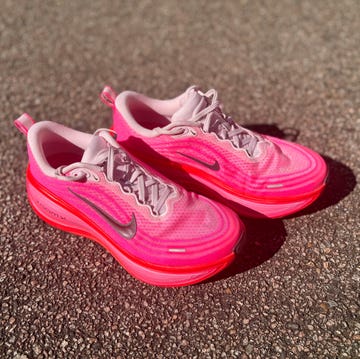Among runners, Mizuno has a long held reputation for crafting durable, reliable training shoes, but in recent years, the brand has also turned out innovative new models, like the Wave Rebellion Pro with its extremely rockered sole shape, that have helped push the boundaries of running shoe design.
Mizuno may lack the instant name recognition of Nike or Adidas, but this company has deep roots — it was founded in 1906 and it has been producing running shoes for nearly a hundred years. Mizuno’s signature running shoe innovation is the ‘wave plate’ midsole feature, first released in 1997. This midsole plate helps dissipate impact forces and stabilises the shoe without adding excessive weight or rigidity, and beloved models like the Wave Inspire still utilise this design.
Other shoes, notably the Neo Zen and Wave Rebellion Pro 3, showcase a new approach for Mizuno: high-stack shoes made with new, lightweight cushioning foams. These models offer top-tier performance on par with other brands’ super trainers and premium racing shoes.
What everyone's reading
Mizuno has managed a delicate balancing act: maintaining (with continual updates) its core stable of tried-and-true training shoes while also experimenting with new tech and developing models that keep pace with the latest trends in shoe design. Whether you’re searching for a stable workhorse, an ultra-cushioned racer, or something in between, this brand has great shoes to choose from — check out our favourites below.
More picks: best New Balance running shoes ● best Hoka running shoes ● best Asics running shoes
Everything you need to know about Mizuno running shoes
Training shoes, such as the Wave Inspire and Wave Rider, form the core of Mizuno’s running shoe lineup. As their names imply, these shoes feature the brand’s signature wave plate in the midsole, creating a stable ride with plenty of cushioning for good shock absorption and rubber outsoles for durability and grip.
Historically, Mizuno shoes have trended toward a notably high drop—models like the Wave Rider and Wave Inspire measure 12mm from heel to toe. Shoes with a steep drop can be an acquired taste–it isn’t for everyone–but having a lot of padding in the heel helps you roll through your stride and transition quickly from landing to toe-off while also requiring less flexibility in your feet and ankles.
One of the brand’s newest shoes, the Wave Rebellion Pro 3, has shifted to a much lower drop on paper (4mm), but it’ll feel different than typical low-drop shoes because it has a sharply rockered sole with a sharp bevel at the heel. This cutout at the rear effectively tilts the shoe forward and forces you to land at mid- to forefoot, where the majority of the padding is.
Along with the Wave Rebellion Pro 3, newer releases like the Neo Zen and Neo Vista showcase the brand’s experimental side. They feature cutting edge new midsole foams that offer exceptional softness and bounce with less weight. The Wave Rebellion Pro 3 also includes a snappy midsole wave plate for maximum energy return—we’d recommend it for race day. The Neo Zen and Neo Vista, on the other hand, are optimised for training, and they work well at a variety of paces.
Wave Plate
Mizuno’s signature shoe feature is the wave plate, a curved piece of plastic made of thermoplastic polyurethane (TPU) or polyether block amide (PEBA), which is embedded in the midsole of the shoe between layers of cushioning. Working in concert with the cushioning, it dissipates impact forces for a softer ride, boosts energy return, and helps the midsole keep its shape, creating a more stable feel underfoot.
Since it was introduced in the 1997 Wave Rider, the wave plate has come to define the classic Mizuno running experience — a stable, well-cushioned, and durable ride.
Some of Mizuno’s newest models feature a revamped wave plate designed for increased speed. The Wave Rebellion Pro 3 features a wave plate that’s infused with carbon fiber. This stiff plate stabilizes the thick sole, so you get maximum cushioning from the midsole foam. It bends at landing and then snaps back into shape at toe-off, boosting the shoe’s energy return and creating a propulsive ride that gets you on your toes quickly.Enerzy cushioning foam
Mizuno cushions its shoes with a range of proprietary ethylene vinyl acetate (EVA) foams called 'Enerzy'. The basic Enerzy foam is made from ethylene vinyl acetate (EVA), the standard cushioning material used across the running shoe industry. Mizuno claims that Enerzy offers 15 percent more energy return than the company’s last generation of EVA foam, U4ic.
In 2024, Mizuno introduced a new ultralight EVA foam, Enerzy NXT, in the fantastically bouncy Neo Vista trainer. NXT is lighter, softer, and more responsive than standard Enerzy, delivering a combination of softness and rebound that makes the shoe feel buoyant underfoot. It’s now used in shoes across the Mizuno lineup, including the Wave Horizon 8 and Wave Inspire 21.
Confusingly, there’s also a version of Enerzy NXT that has totally different chemistry: Instead of EVA, it’s made from thermoplastic polyurethane (TPU) formed through a supercritical process, which leaves small gas bubbles suspended evenly inside the foam. The result? It’s much softer and has superior energy return compared to the EVA-based Enerzy NXT. It’s found in the Neo Zen, and it gives the shoe its plush-yet-bouncy feel.
The latest version of Enerzy is called Enerzy XP, and it’s used in the midsole of the Wave Rebellion Pro 3. This is a supercritical thermoplastic polyester elastomer (TPEE) foam. The gas bubbles suspended within the foam make it incredibly light and responsive, and the TPEE material has superior resilience, which makes the midsole more durable. According to Mizuno, Enerzy XP is the lightest, most responsive cushioning material in its entire lineup, and it’s what makes the Wave Rebellion Pro 3 so springy and propulsive.
How we selected the best Mizuno running shoes
To pick the best Mizuno running shoes, we reviewed the company’s shoe line-up and talked with a brand rep to learn about its latest models and innovations. We pulled insights from Runner’s World reviews and testing data, incorporating our own firsthand experiences where appropriate. Based on all that data as well as RW editor input, we chose the shoes below. This line-up showcases Mizuno’s premier foams, wave plate designs, and other features, and it includes shoes suitable for a variety of running scenarios, from daily training to racing and more.
Our full Mizuno running shoe reviews
The Neo Zen showcases some of Mizuno’s newest running shoe tech, and it earned a spot in our 2025 Shoe Award's for its appealing blend of soft cushioning, low weight, and a smooth ride. RW testers universally appreciated its comfortable feel for daily training.
The Neo Zen utilises Mizuno’s TPU-based Enerzy NXT cushioning foam, and this compound serves up a notably plush sensation —one tester compared it to ‘running on a marshmallow’. The foam also provides a dose of energy return, testers reported, and combined with the shoe’s overall low weight, they found the Neo Zen to be quite versatile — soft enough for recovery jogs but lively enough to help you pick up the pace at the end of a long run.
The sole curves upward at the front for smooth transitions from landing to toe-off, and it’s capped with a one-piece knit upper that breathes well, so your feet won’t overheat during hot weather. The upper also features an integrated tongue, which proved divisive among our testers. Some liked the streamlined design, but others had issues getting a secure fit.
Overall, the Neo Zen is an exciting offering that shows Mizuno is experimenting with the latest trend in training shoes—bouncy high-stack midsoles. If you want a well-cushioned shoe that doesn’t sacrifice a peppy feel, the Neo Zen is absolutely worth a try.
If a shoe has survived for 21 iterations, you know it must have a strong following, and that’s certainly the case with the Wave Inspire 21. A favorite among stability-minded runners, this shoe offers a supportive ride and a durable build that’ll help you power through your training miles.
The latest Wave Inspire has a midsole with regular Enerzy foam on top of a layer of EVA-based Enerzy NXT foam for a soft underfoot sensation and good shock absorption. It’s paired with a wave plate that stiffens the sole (though it still allows for good front-to-back flexibility) and helps counter overpronation, keeping your foot aligned within the shoe as you run.
Up top, a jacquard mesh upper with plenty of padding around the ankle and on the tongue creates a snug, comfortable fit around the foot. On the bottom, the Wave Inspire rides on a full-coverage rubber outsole, so you’ll get reliable grip on the pavement and high-mileage durability, too.
The Wave Inspire is what Mizuno diehards love: a trusty workhorse that you can rack up miles in. It’s a solid pick for overpronators or any runner who likes a planted, comfortable feel in their shoes.
The new Mizuno Neo Vista is so thick it’s illegal — for pros, at least. Ultraplush shoes with sky-high stack heights are all the rage, but most shoemakers try to keep their cushioning under World Athletics’ 40mm limit for international competition.
The Neo Vista stands tall with 44.5mm of Mizuno’s EVA-based Enerzy NXT foam in the heel and 36.5mm in the forefoot, creating a nearly bottomless feeling underfoot. It features a cut-out down the length of the midsole, rather than a midsole plate, to let the foam compress more easily and shave down weight, maximising its lightweight, airy ride.
‘I get the sensation of just bouncing along down the road, unbound by gravity,’ said one tester.
The shoe is also far lighter than you’d expect given the amount of foam underfoot. Perhaps more impressively, it achieves that ultralight, ultraplush profile without using more expensive, more fragile materials like PEBA, which are found in similar super shoes.
With the RW test editors reaching for the Neo Vista more often than most of the shoes in their rotation, we’re confident most runners looking for an exciting, plush neutral shoe will like it, too. And at less than £200, it’s a solid choice for both training and race day.
The Wave Rebellion Pro 3 is Mizuno’s racing super shoe, and with its outlandish sole shape and spicy, propulsive ride, it’s a genuine standout in a category full of unique shoes.
Notable tech in the Wave Rebellion Pro 3 includes a new midsole foam called Enerzy XP. This supercritical cushioning is softer and bouncier than the Enerzy Lite and Lite+ foams used in the previous version of the shoe. The sole features pronounced toe spring and a massive heel bevel that encourages midfoot landings and lightning-fast transitions to toe-off. (The sculpted sole is also a sneaky way of keeping the heel stack under the 40mm World Athletics limit for international competition.)
A carbon fibre-infused wave plate stiffens the sole and helps you maximiwe the energy return from the thick stack of foam. The shoe is topped with a thin mesh upper and has a surprisingly generous rubber outsole for good grip on the pavement.
Among RW testers, the latest Wave Rebellion Pro was a polarising shoe. Multiple testers reported irritation issues with the minimalist upper (there’s no soft padding around the ankle, so crew socks are essential equipment). The unique sole shape pushed the testers onto their toes as they ran, which worked well for midfoot strikers, though heel strikers felt unstable. Overall, most testers were blown away by the shoe’s propulsive feel: ‘The thing is a rocket ship,’ said one. If you’re looking for some extra oomph for race day, the Wave Rebellion Pro 3 has plenty of it.
Mizuno’s flagship stability shoe, the Wave Horizon, offers a planted feel and high-mileage durability, making it a great choice for powering through a training routine.
In terms of shoe tech, the latest version largely sticks to the same script as its predecessor. Unlike other Mizuno training shoes, this model lacks a wave plate, but its dual-layer midsole is cut in an undulating wave pattern. This shape allows the shoe to flex as you roll through your stride, but it resists twisting, so it’ll counter the inward lean of overpronation and keep your feet stable. In addition, the very wide sole shape creates a planted feel, and a layer of rubber on the medial side of the shoe supports the arches of your feet as you run.
The midsole features a top layer of Enerzy NXT foam and a bottom layer of Enerzy foam for a good balance between plush shock absorption and firm support. Finally, a well-padded stretch woven midsole creates a close, comfortable wrap around the foot, and the carbon rubber outsole has the durability to last through plenty of mileage.
Although it’s certainly not light, the Wave Horizon 8 is a compelling choice for runners who prize stability and longevity in their shoes. This is another classic Mizuno workhorse: It’s comfortable, it offers a smooth, predictable ride, and it’s built to last.
The Wave Rider has long been Mizuno’s neutral do-it-all shoe, and the Wave Rider 28 promises an even smoother ride with more breathability than its predecessor. The latest Wave Rider is a fairly modest revision of last year’s model, but that’s fine by us: RW testers loved the Wave Rider 27 for its sporty, responsive ride and ability to dissipate impact forces, especially at the heel.
The biggest change is a small dose of Mizuno’s new ultralight Enerzy NXT foam in the heel. Switching to a lighter, softer foam in that spot shaves a few grams off the shoe, while bolstering the cushion where most runners touch down first.
It also features a new jacquard mesh upper design that strives for better breathability than its predecessor. It also features an upturned heel counter to make the shoe easier to slide on and off your foot.
The other key components of the Wave Rider remain in place: The PEBA wave plate returns, adding stability and pep, as does the primary layer of Enerzy foam padding. We’d expect the same type of moderately cushioned and responsive ride that we’ve come to expect from this shoe. The Wave Rider 28 is ideal for neutral heel strikers or midfoot strikers who don’t mind a more forward-leaning posture.
The Wave Sky is Mizuno’s max-cushion daily trainer, and it serves up a comfort-focused ride that’s ideal for mellow jogs and run-walking.
Compared to the outgoing version, the Wave Sky 8 features a new, lighter stretch woven upper and an updated dual-foam midsole setup: a thick layer of soft Enerzy NXT on top of regular Enerzy foam for a cushy ride that takes the sting out of long days on your feet.
The sole also has a relatively wide shape, which gives the shoe a planted, confident feel (although it lacks the stabilising wave plate found on other Mizuno models like the Wave Inspire 21). The Wave Sky is built to hold up through high mileage thanks to its tough carbon rubber outsole, and the outsole is scored with lateral grooves to promote smooth transitions from landing to toe-off.
A sturdy trainer with a generous helping of midsole cushioning, the Wave Sky 8 will give you a comfortable ride at any pace from walking to running.
Q+A with running shoe expert Michael Charboneau

Morgan is a gear editor who has been with Runner’s World since 2017. She started as an intern ghostwriting The Warmup, a bygone version of the daily RW newsletter. Now, she tests and reviews anything you might find on runners’ feet-from crew socks and compression boots to carbon-plated super shoes.
A lifelong runner and shoe geek, Morgan has been chasing the perfect pair of kicks since she joined her grade school cross-country team. Since then, she ran as a Division I walk-on for the cross-country and track & field teams at the University of Delaware, where she studied English and Biology. She has one full marathon under her belt, and has raced more halfs and 5Ks than she can count.












